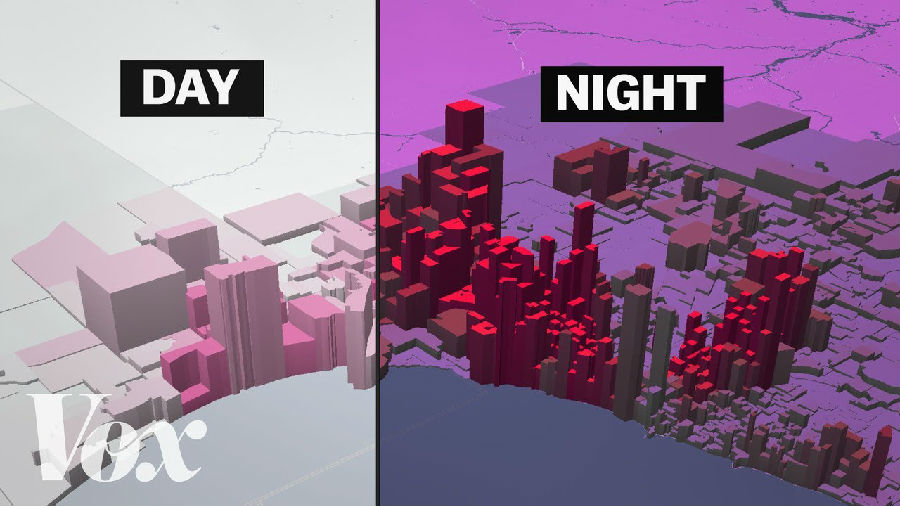And if there's too many colored people around here, I definitely will get out.
如果家附近有太多有色人种,我绝对是会搬走的。
One of the main reasons was because it was a white community.
一个主要的原因是这是一个白人社区。
And we understood that it was going to be all white and we were very happy to buy a home here.
我们知道这个社区会是一个纯白人的社区,我们也很乐意在这儿买房子。
This was Levittown, Pennsylvania, shortly after World War II.
这是二战后不久宾夕法尼亚州的里维特社区。
In a suburb that explicitly promised a white-only neighborhood.
这是一个明确承诺只允许白人居住的社区。
And it wasn't some outlier.
这个社区并不是什么特殊的社区。
It was THE prototypical suburb, built by THE father of suburbia — Bill Levitt — who created several suburbs around the US, all named Levittown.
而是“城郊社区之父”比尔·里维特修建的一个典型的郊区社区,他在美国各地都修建了这种社区,并统一命名为“里维特社区”。
But one reason Levitt wanted a white-only community was because the US government was subsidizing it — and that's what they wanted.
但里维特修建白人社区的原因之一是美国政府当时正在资助这种社区——因为这种社区正是他们想要的社区。
They said they didn't want “racially inharmonious groups” lowering property values.
他们表示,他们不想让“种族不和谐人群”来降低房地产的价值。
That's why Levitt didn't just sell cookie-cutter houses.
这也是为什么里维特卖的不止是千篇一律的一种房型的原因。
He sold a meticulously crafted, affordable, utopian lifestyle.
他卖的是一种精心制作,大家也能负担得起的乌托邦式的生活方式。
So as the courts integrated public spaces, like schools, more and more white people fled to these suburbs.
所以,随着这类社区纳入学校等公共空间,逃到郊区去的白人就越来越多了。
And these patterns are still the defining characteristic of America's racial geography.
这种结构图也仍然是美国种族地理的决定性特征。
But we now spend most of our time at work.
然而,如今我们大部分时间都花在了工作上。
And there, it gets a lot more complicated.
白人居住选择的问题也就由此变得更为复杂了。
“More than a million persons each year have pulled up stakes in the city and turned commuter…”
“每年都有超过100万人搬离城市,成为通勤一族。”
Shortly after the first Levittown broke ground in 1947 in Long Island, New York,
1947年纽约长岛第一个里维特社区破土动工后不久,
about 80 percent of men still commuted the hour to Manhattan.
仍有将近80%的男性挤着高峰去曼哈顿上班。
And while neighborhoods were getting deeply segregated, these workplaces were getting more diverse.
社区出现严重隔离,这些工作场所却变得更加多样化了。

The Civil Rights Act of 1964 banned employment discrimination.
1964年的《民权法案》禁止就业歧视。
More companies explicitly said they were “equal opportunity employers.”
明确表示自己是“机会均等的雇主”的企业多了起来。
And segregation within our workplaces declined.
工作场所的种族隔离问题也变得少了。
This meant the workplace was a crucial environment for us to interact with people of other races.
这就意味着,工作场所是我们同其他种族的人交流的一个关键场所。
Except that's not exactly how it turned out.
但事实并非如此。
A few months ago, researchers at Cornell and Penn State shared a dataset with me — and when I mapped it, it kind of blew my mind.
几个月前,康奈尔大学和宾夕法尼亚州立大学的研究人员跟我分享了一个数据集——当我绘制出来后,结果让我大吃一惊。
This is a map of where people work in modern-day Chicago.
这是一张展示现代芝加哥人都在哪儿工作的地图。
The taller an area, the more people there are.
越高的地方,人就越多。
But now, let's color in each neighborhood by the percentage of white people.
现在,让我们用颜色来表示每个社区白人所占的比例。
You can see the city centers are pretty diverse.
可以看出,市中心是比较多样化的。
But, now, here's what happens when they go home.
但当他们回家以后,情况就变成了这样。
What's even more astounding is what happens when we map people of color.
更令人震惊的是绘制有色人种的地图时得出的结果。
Here's where black people work in Chicago.
这里是黑人在芝加哥工作的地方。
Again, they're concentrated in diverse city centers.
同样,他们也集中在人种较为多样化的各个城市中心。
But when black workers go home, they go to very segregated neighborhoods, clustered in the poorer areas.
但当黑人工薪阶层下班以后,他们去了隔离非常严重的社区,而这些社区通常又聚集在比较贫穷的地方。
And we can see the same patterns in DC. Detroit. Philadelphia.
而在华盛顿,底特律,费城,我们也能看到这种情况。
Pretty much everywhere in the US.
可以说美国的各个地方都有这种情况。
These maps shows just how stubborn residential segregation is.


